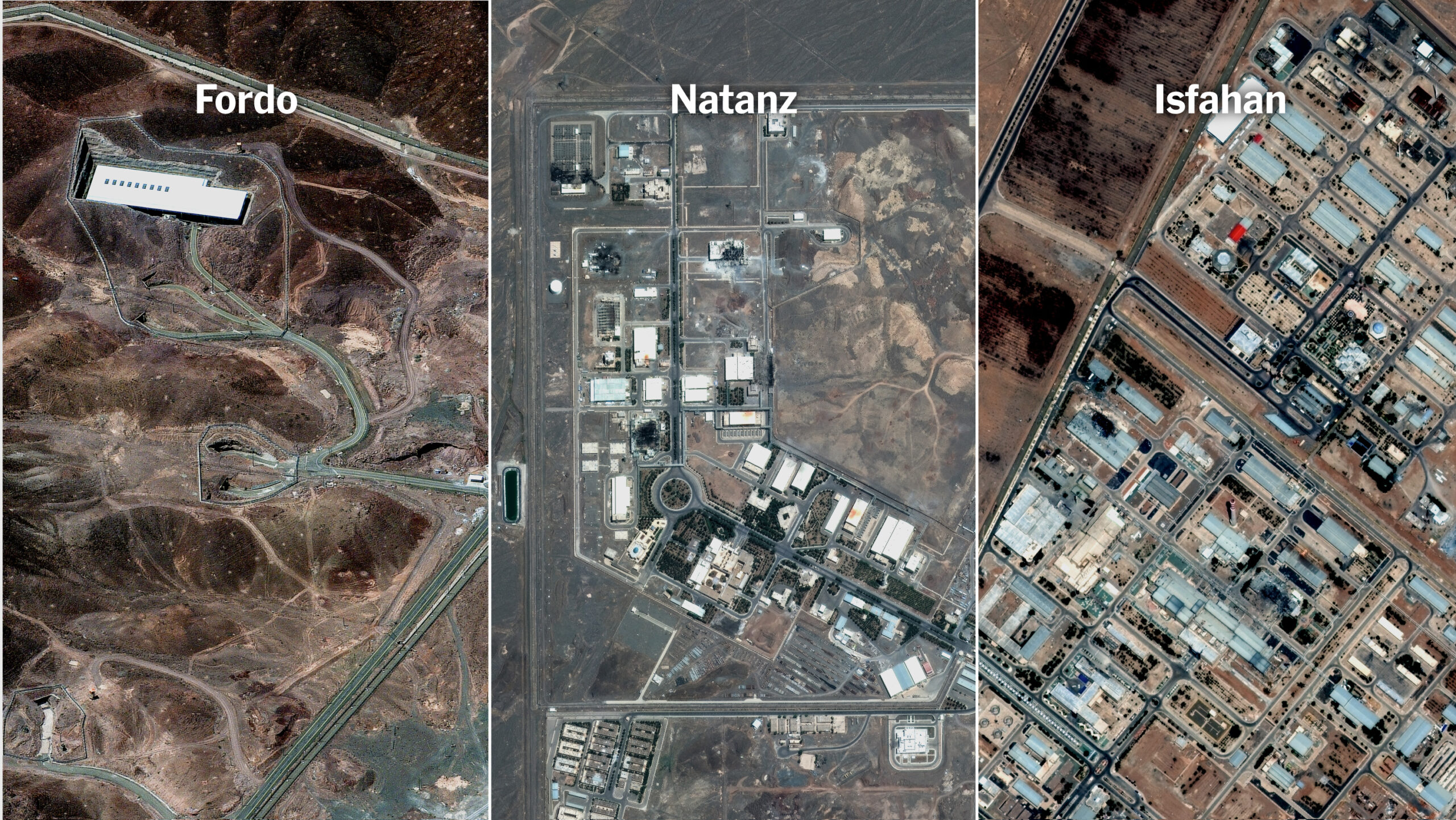
Here Are the Three Iranian Nuclear Sites the U.S. Attacked
How did your country report this? Share your view in the comments.
Diverging Reports Breakdown
Here Are the Three Iranian Nuclear Sites the U.S. Attacked
The U.S. struck three key nuclear sites in Iran overnight on Saturday, joining Israel’s war against Iran and potentially triggering a more dangerous phase in the conflict. President Trump claimed in an address shortly after the strikes that Iran’s nuclear sites had been “completely and totally obliterated” The Atomic Energy Organization of Iran confirmed that the three sites had was attacked, and it said that it would take legal action against theU.S in international courts. The New York Times analysis of satellite imagery from Airbus, Maxar Technologies and local news reports; and verified social photos and videos. Note: Map shows confirmed locations of strikes and is not comprehensive, but does not show the exact location of all the strikes or the extent of the damage done to the facilities. The International Atomic Energy Agency said on Monday that the electrical infrastructure at the plant had been destroyed by Israeli strikes. The nuclear fuel is thought to be stored at a complex outside the ancient capital of Isfahan, though it was unclear whether it was viewed as recently as two weeks ago.
The U.S. struck three key nuclear sites in Iran overnight on Saturday, joining Israel’s war against Iran and potentially triggering a more dangerous phase in the conflict.
Where the U.S. attacked Iran American strikes Israeli strikes since June 13 Iran Israel Iraq Saudi
Arabia Afghanistan Turkmenistan Qatar Tehran Tabriz Fordo Bunker-buster bombs were dropped on Iran’s most critical nuclear site.
Natanz Israeli attacks had already damaged the country’s largest uranium enrichment center.
Isfahan Near-bomb-grade nuclear fuel is thought to be stored here. Sources: New York Times analysis of satellite imagery from Airbus, Maxar Technologies and Planet Labs; local news reports; and verified social photos and videos. Note: Map shows confirmed locations of strikes and is not comprehensive. The New York Times
A U.S. official said that six American warplanes dropped a dozen 30,000-pound bunker-busters on the Fordo nuclear site, and that Navy submarines fired 30 cruise missiles at the Natanz and Isfahan sites. One B-2 bomber also dropped two bunker-busters on Natanz, the official said.
President Trump claimed in an address shortly after the strikes that Iran’s nuclear sites had been “completely and totally obliterated.” The Atomic Energy Organization of Iran confirmed that the three sites had been attacked, and it said that it would take legal action against the U.S in international courts.
These are the nuclear facilities that the U.S. hit.
Fordo
Fordo is Iran’s most critical nuclear enrichment facility, housed deep inside a mountain to shield it from attacks. Only the U.S. military possesses bombs that could hit the site, and multiple bombs would need to be dropped on the same location to reach the facility.
Fordo nuclear site Deep inside a mountain, Fordo is said to contain close to 3,000 sophisticated centrifuges in two enrichment halls. IRAN Support building Tunnel entrances Security perimeter Fordo nuclear site IRAN Deep inside a mountain, Fordo is said to contain close to 3,000 sophisticated centrifuges in two enrichment halls. Support building Tunnel entrances Security perimeter Fordo nuclear site Deep inside a mountain, Fordo is said to contain close to 3,000 sophisticated centrifuges in two enrichment halls. IRAN Support building Tunnel entrances Security perimeter Sources: Nuclear Threat Initiative; Google Earth (terrain) By Samuel Granados
A U.S. official said that initial damage assessments indicated that the facility had been “taken off the table.”
An Iranian lawmaker said in a post on social media that the site had been evacuated “a long time ago” in anticipation of attacks.
Natanz
Electrical substation IRAN NATANZ ENRICHMENT COMPLEX Underground enrichment halls Pilot fuel enrichment plant Entrance IRAN Electrical substation NATANZ ENRICHMENT COMPLEX Underground enrichment halls Pilot fuel enrichment plant Entrance Electrical substation IRAN NATANZ ENRICHMENT COMPLEX Underground enrichment halls Pilot fuel enrichment plant Entrance Sources: Institute for Science and International Security, Nuclear Threat Initiative, Israel Defense Forces; satellite image taken on June 15, 2025, by Maxar Technologies. The New York Times
Natanz is the site of Iran’s largest uranium enrichment center and has been damaged in multiple strikes by the Israeli military.
Damage from previous Israeli strikes Damaged electric substation Destroyed by Israel in 2020 Pilot fuel enrichment plant destroyed Source: Institute for Science and International Security. Satellite image by Maxar Technologies. By Bora Erden, Marco Hernandez and Karen Yourish
Above-ground facilities at Natanz were damaged on the first day of Israel’s strikes. The International Atomic Energy Agency said on Monday that the electrical infrastructure at the plant had been destroyed by Israeli strikes, and that the loss of power may have also damaged the centrifuges at the site.
Isfahan
IRAN ISFAHAN NUCLEAR FUEL RESEARCH AND PRODUCTION CENTER IRAN ISFAHAN NUCLEAR FUEL RESEARCH AND PRODUCTION CENTER IRAN ISFAHAN NUCLEAR FUEL RESEARCH AND PRODUCTION CENTER Source: Satellite image taken on June 14, 2025 by Maxar Technologies The New York Times
Near-bomb-grade nuclear fuel is thought to be stored at a complex outside the ancient capital of Isfahan. International inspectors viewed the supplies of fuel as recently as two weeks ago, though it was unclear whether Iran had moved those supplies in recent days, as some Iranian officials suggested.
If the site is destroyed, it could delay the Iranian nuclear program by years, unless undetected parallel facilities exist.
The Israeli military had previously struck laboratories at the facility that work to convert uranium gas into the form that would be needed to actually produce a weapon. Israeli fighter jets had struck the facility again prior to the U.S. bombing, according to the Israeli military and a state-affiliated Iranian news agency.
Source: https://www.nytimes.com/interactive/2025/06/22/world/middleeast/us-iran-nuclear-sites.html
